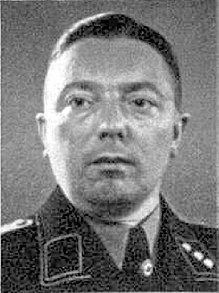Karl Viererbl
Karl Viererbl (* July 24, 1903 in Komotau ; † July 13, 1945 in Vroutek , Czechoslovakia ) or by pseudonyms Kurt Vorbach or Ernst Kämper was a German journalist and politician ( DNSAP / NSDAP ).
Life
Viererbl attended the humanistic high school in Komotau after elementary school. He then studied history, German, philosophy and geography at the German University of Prague from 1922 and received his doctorate in philosophy in 1926 . After completing his studies, he worked as a teacher at a German private school in Kladno from 1927 to 1930 . He then worked as an editor at the Saazer Anzeiger and then at the German-Austrian daily newspaper before he became the chief editor of the journalistic organ of the German National Socialist Workers' Party (DNSAP), Der Tag . He also became a member of the national leadership of the DNSAP.
After the party dissolved itself as a result of the impending ban, he moved to Germany in 1933. From that year he headed Konrad Henlein's foreign press office in Berlin . From January 1934 he was editor of the foreign policy department of the Völkischer Beobachter , the party organ of the NSDAP, as a “Volkstumsperte” editor . Until 1939 he worked as an editor for the Völkischer Beobachter . In addition, from 1935 he was lecturer of the party official examination commission for the protection of German literature . He also worked for the SS combat and advertising newspaper Das Schwarze Korps . From 1935 to 1939 he was also a lecturer at the School of Politics and the Foreign Policy Training House of the NSDAP. He became a member of the NSDAP in 1937 and the SS in 1938 . In the SS he reached the rank of Sturmbannführer.
In the supplementary election on December 4, 1938 after the annexation of the Sudetenland to the German Reich, he was elected to the National Socialist Reichstag , to which he was a permanent member. On May 1, 1939, he became editor-in-chief of the Sudeten German Nazi newspaper Die Zeit . At the Gauleitung in Reichsgau Sudetenland he became chief editor of the Gaupresse, Gauamtsleiter and finally Gaupresseamtsleiter. In addition, Viererbl was head of the Sudetenland regional association in the Reich Association of the German Press. In 1943 he became honorary professor for newspaper studies at the so-called Reich University in Prague . Viererbl died shortly after the end of the Second World War in custody in Rudig near Podersam .
Viererbl's writings Stupidity? Witch madness, the devil's ghost and fraudulent relics ( Ludendorff , Munich 1937), Political Catholicism (Leipzig, Fritsch 1937), From Marbod to Benesch (Luser, Vienna 1938) and From the meaning of the present, small essays on current events (Kraft, Karlsbad 1943) and that Sudetenland im Reich published by him (Kraus, Reichenberg 1943) were placed on the list of literature to be sorted out in the Soviet occupation zone . In the German Democratic Republic this list was followed by Viererbl's writings Christian or Christian-Social? (NSP.-Verlag, Aussig 1932) and 200,000 Sudeten Germans too many! ( Deutscher Volksverlag , Munich 1936).
literature
- Joachim Lilla , Martin Döring, Andreas Schulz: extras in uniform. The members of the Reichstag 1933–1945. A biographical manual. Including the ethnic and National Socialist members of the Reichstag from May 1924. Droste, Düsseldorf 2004, ISBN 3-7700-5254-4 .
- Joachim Lilla: The representation of the “Reichsgau Sudetenland” and the “Protectorate of Bohemia and Moravia” in the Grossdeutsche Reichstag. In: Bohemia . Journal of the history and culture of the Czech lands. Volume 40, number 2, 1999, pp. 436-471, here p. 469, doi : 10.18447 / BoZ-1999-1796 .
Web links
- Literature by and about Karl Viererbl in the catalog of the German National Library
- Karl Viererbl in the database of members of the Reichstag
Individual evidence
- ^ Joachim Lilla , Martin Döring, Andreas Schulz: extras in uniform. The members of the Reichstag 1933–1945. A biographical manual. Including the ethnic and National Socialist members of the Reichstag from May 1924. Droste, Düsseldorf 2004, ISBN 3-7700-5254-4 .
- ↑ a b c d e Joachim Lilla: The representation of the "Reichsgau Sudetenland" and the "Protectorate of Bohemia and Moravia" in the Greater German Reichstag. In: Bohemia. Journal of the history and culture of the Czech lands. Volume 40, number 2, 1999, pp. 436-471, here p. 469.
- ↑ a b Lars Jockheck: The "Volkischer Beobachter" Poland 1932-1934. A case study on the transition from the “Kampfblatt” to the “Government newspaper” (= Eastern Europe. 22). Lit, Hamburg 1999, ISBN 3-8258-4359-9 , p. 39.
- ^ A b c Ine Van Linthout: The book in the National Socialist propaganda policy (= studies and texts on the social history of literature. 131). Walter de Gruyter, Berlin / Bosten 2012, ISBN 978-3-11-025271-2 , p. 105, footnote 87.
- ↑ Erich Stockhorst: 5000 heads. Who was what in the 3rd Reich . Arndt, Kiel 2000, ISBN 3-88741-116-1 , p. 430 (Unchanged reprint of the first edition from 1967).
- ↑ http://www.polunbi.de/bibliothek/1946-nslit-k.html
- ↑ http://www.polunbi.de/bibliothek/1947-nslit-k.html
- ↑ http://www.polunbi.de/bibliothek/1948-nslit-v.html
- ↑ http://www.polunbi.de/bibliothek/1946-nslit-v.html
- ↑ http://www.polunbi.de/bibliothek/1953-nslit-v.html
- ↑ http://www.polunbi.de/bibliothek/1953-nslit-v.html
| personal data | |
|---|---|
| SURNAME | Viererbl, Karl |
| ALTERNATIVE NAMES | Vorbach, Kurt (pseudonym); Fighter, Ernst (pseudonym) |
| BRIEF DESCRIPTION | German journalist and politician (DNSDAP, NSDAP), MdR |
| DATE OF BIRTH | July 24, 1903 |
| PLACE OF BIRTH | Komotau |
| DATE OF DEATH | July 13, 1945 |
| Place of death | Vroutek |
